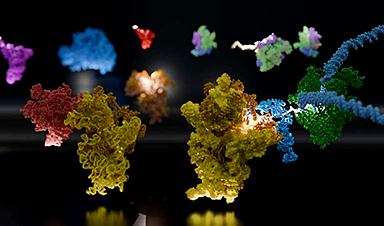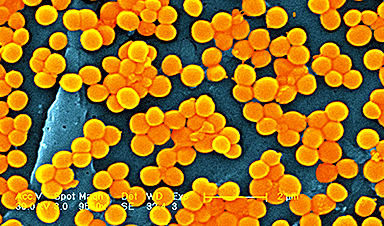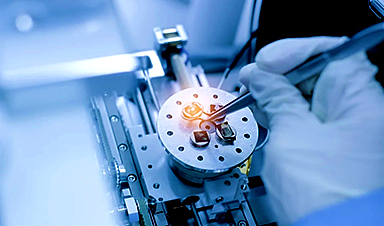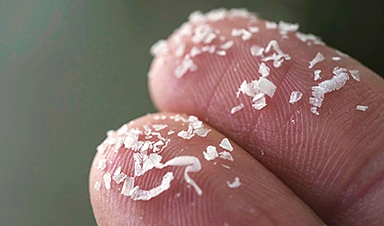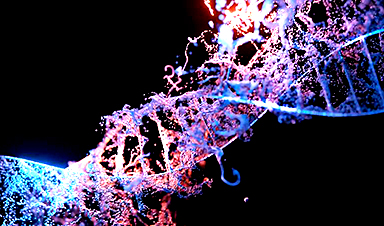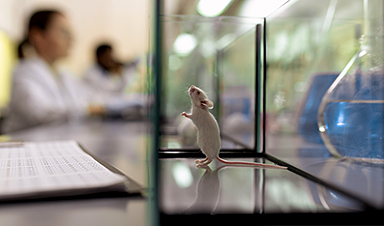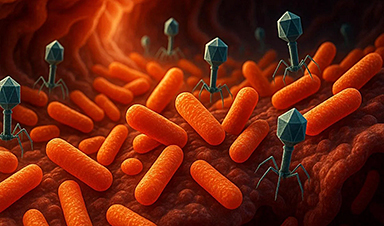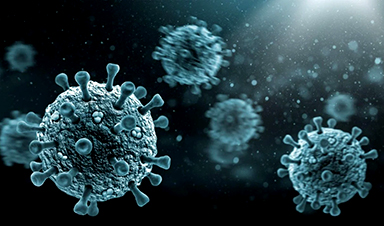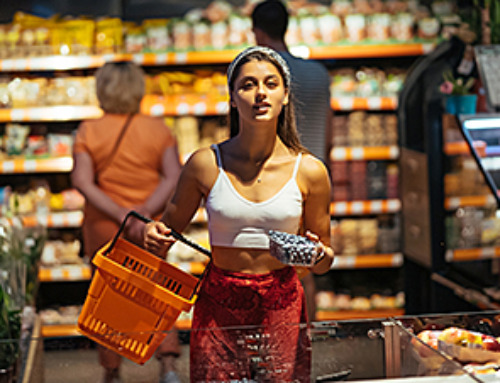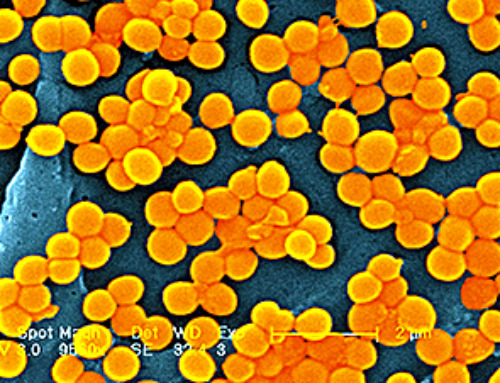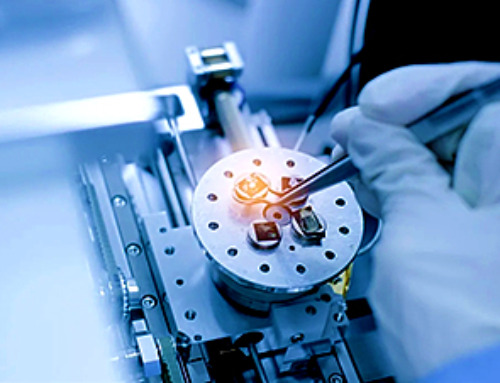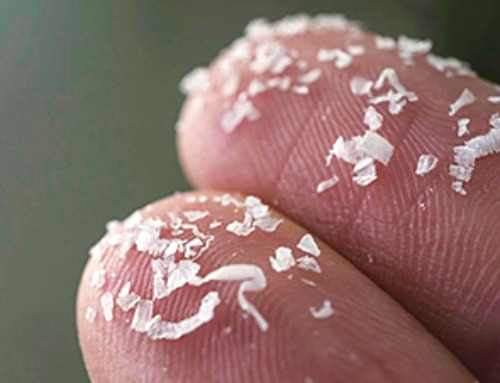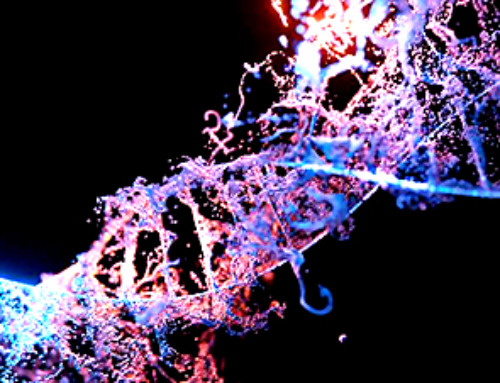Within a cell, DNA carries the genetic code for building proteins. To build proteins, the cell makes a copy of DNA, called mRNA. Then, another molecule called a ribosome reads the mRNA, translating it into protein. But this step has been a visual mystery; scientists previously did not know how the ribosome attaches to and reads mRNA.
Now, a team of international scientists, including University of Michigan researchers, has used advanced microscopy to image how ribosomes recruit to mRNA while it’s being transcribed by an enzyme called RNA polymerase (RNAP). Their results, which examine the process in bacteria, are published in the journal Science.
“Understanding how the ribosome captures or ‘recruits’ the mRNA is a prerequisite for everything that comes after, such as understanding how it can even begin to interpret the information encoded in the mRNA,” said Albert Weixlbaumer, a researcher from Institut de génétique et de biologie moléculaire et cellulaire in France who co-led the study.
“It’s like a book. Your task is to read and interpret a book, but you don’t know where to get the book from. How is the book delivered to the reader?”
The researchers discovered that the RNAP transcribing the mRNA deploys two different anchors to rope in the ribosome and ensure a solid footing and start of protein synthesis. This is similar to a foreperson at a construction site overseeing workers installing a complex section of the superstructure, confirming in two redundant ways that all the pieces are fastened securely at critical junctures for maximum stability and functionality.
Understanding these fundamental processes holds great potential for developing new antibiotics that target these specific pathways in bacterial protein synthesis, according to the researchers. Traditionally, antibiotics have targeted the ribosome or RNAP, but bacteria often find a way to evolve and mutate to create some resistance to those antibiotics. Armed with their new knowledge, the team hopes to outwit bacteria by cutting off multiple pathways.
“We know there is an interaction between the RNAP, the ribosome, transcription factors, proteins and mRNA,” said U-M senior scientist Adrien Chauvier, one of four co-leaders of the study. “We could target this interface, specifically between the RNAP, ribosome, and mRNA, with a compound that interferes with the recruitment or the stability of the complex.”
The team developed a mechanistic framework to show how the various components of the complex work together to bring freshly transcribed mRNAs to the ribosome and act as bridges between transcription and translation.
“We wanted to find out how the coupling of RNAP and the ribosome is established in the first place,” Weixlbaumer said. “Using purified components, we reassembled the complex—10-billionth of a meter in diameter. We saw them in action using cryo-electron microscopy (cryo-EM) and interpreted what they were doing. We then needed to see if the behavior of our purified components could be recapitulated in different experimental systems.”
In more complex human cells, DNA resides in the walled-off nucleus, where RNAP serves as the “interpreter,” breaking down genetic instructions into smaller bites. This dynamo of an enzyme transcribes, or writes, the DNA into mRNA, representing a specifically selected copy of a small fraction of the genetic code that is moved to the ribosome in the much “roomier” cytoplasm, where it is translated into proteins, the basic building blocks of life.
In prokaryotes, which lack a distinct nucleus and internal membrane “wall,” transcription and translation happen simultaneously and in close proximity to each other, allowing the RNAP and the ribosome to directly coordinate their functions and cooperate with each other.
Bacteria are the best-understood prokaryotes, and because of their simple genetic structure, provided the team with the ideal host to analyze the mechanisms and machinery involved in the ribosome-RNAP coupling during gene expression.
The researchers employed various technologies and methodologies per each lab’s specialty—cryo-EM in Weixlbaumer’s group, and the Berlin group’s in-cell crosslinking mass spectrometry carried out by Andrea Graziadei—to examine the processes involved.
With expertise in biophysics, Chauvier and Nils Walter, U-M professor of chemistry and biophysics, utilized their advanced single molecule fluorescence microscopes to analyze the kinetics of the structure.
“In order to track the speed of this machinery at work, we tagged each of the two components with a different color,” Chauvier said. “We used one fluorescent color for the nascent RNA, and another one for the ribosome. This allowed us to view their kinetics separately under the high-powered microscope.”
They observed that the mRNA emerging from RNAP was bound to the small ribosomal subunit (30S) particularly efficiently when ribosomal protein bS1 was present, which helps the mRNA unfold in preparation for translation inside the ribosome.
The cryo-EM structures of Webster and Weixlbaumer pinpointed an alternative pathway of mRNA delivery to the ribosome, via the tethering of RNA polymerase by the coupling transcription factor NusG, or its paralog, or version, RfaH, which thread the mRNA into the mRNA entry channel of the ribosome from the other side of bS1.
Having successfully visualized the very first stage in establishing the coupling between RNAP and the ribosome, the team looks forward to further collaboration to find out how the complex must rearrange to become fully functional.
“This work demonstrates the power of interdisciplinary research carried out across continents and oceans,” said Walter.
Huma Rahil, a doctoral student in the Weixlbaumer lab, and Michael Webster, then a postdoctoral fellow in the lab and now of The John Innes Centre in the United Kingdom, co-led the paper as well.
More information: Michael W. Webster et al, Molecular basis of mRNA delivery to the bacterial ribosome, Science (2024). DOI: 10.1126/science.ado8476. www.science.org/doi/10.1126/science.ado8476
Journal information: Science
Provided by University of Michigan
News
How the FDA opens the door to risky chemicals in America’s food supply
Lining the shelves of American supermarkets are food products with chemicals linked to health concerns. To a great extent, the FDA allows food companies to determine for themselves whether their ingredients and additives are [...]
Superbug crisis could get worse, killing nearly 40 million people by 2050
The number of lives lost around the world due to infections that are resistant to the medications intended to treat them could increase nearly 70% by 2050, a new study projects, further showing the [...]
How Can Nanomaterials Be Programmed for Different Applications?
Nanomaterials are no longer just small—they are becoming smart. Across fields like medicine, electronics, energy, and materials science, researchers are now programming nanomaterials to behave in intentional, responsive ways. These advanced materials are designed [...]
Microplastics Are Invading Our Arteries, and It Could Be Increasing Your Risk of Stroke
Higher levels of micronanoplastics were found in carotid artery plaque, especially in people with stroke symptoms, suggesting a potential new risk factor. People with plaque buildup in the arteries of their neck have been [...]
Gene-editing therapy shows early success in fighting advanced gastrointestinal cancers
Researchers at the University of Minnesota have completed a first-in-human clinical trial testing a CRISPR/Cas9 gene-editing technique to help the immune system fight advanced gastrointestinal (GI) cancers. The results, recently published in The Lancet Oncology, show encouraging [...]
Engineered extracellular vesicles facilitate delivery of advanced medicines
Graphic abstract of the development of VEDIC and VFIC systems for high efficiency intracellular protein delivery in vitro and in vivo. Credit: Nature Communications (2025). DOI: 10.1038/s41467-025-59377-y. https://www.nature.com/articles/s41467-025-59377-y Researchers at Karolinska Institutet have developed a technique [...]
Brain-computer interface allows paralyzed users to customize their sense of touch
University of Pittsburgh School of Medicine scientists are one step closer to developing a brain-computer interface, or BCI, that allows people with tetraplegia to restore their lost sense of touch. While exploring a digitally [...]
Scientists Flip a Gut Virus “Kill Switch” – Expose a Hidden Threat in Antibiotic Treatment
Scientists have long known that bacteriophages, viruses that infect bacteria, live in our gut, but exactly what they do has remained elusive. Researchers developed a clever mouse model that can temporarily eliminate these phages [...]
Enhanced Antibacterial Polylactic Acid-Curcumin Nanofibers for Wound Dressing
Background Wound healing is a complex physiological process that can be compromised by infection and impaired tissue regeneration. Conventional dressings, typically made from natural fibers such as cotton or linen, offer limited functionality. Nanofiber [...]
Global Nanomaterial Regulation: A Country-by-Country Comparison
Nanomaterials are materials with at least one dimension smaller than 100 nanometres (about 100,000 times thinner than a human hair). Because of their tiny size, they have unique properties that can be useful in [...]
Pandemic Potential: Scientists Discover 3 Hotspots of Deadly Emerging Disease in the US
Virginia Tech researchers discovered six new rodent carriers of hantavirus and identified U.S. hotspots, highlighting the virus’s adaptability and the impact of climate and ecology on its spread. Hantavirus recently drew public attention following reports [...]
Studies detail high rates of long COVID among healthcare, dental workers
Researchers have estimated approximately 8% of Americas have ever experienced long COVID, or lasting symptoms, following an acute COVID-19 infection. Now two recent international studies suggest that the percentage is much higher among healthcare workers [...]
Melting Arctic Ice May Unleash Ancient Deadly Diseases, Scientists Warn
Melting Arctic ice increases human and animal interactions, raising the risk of infectious disease spread. Researchers urge early intervention and surveillance. Climate change is opening new pathways for the spread of infectious diseases such [...]
Scientists May Have Found a Secret Weapon To Stop Pancreatic Cancer Before It Starts
Researchers at Cold Spring Harbor Laboratory have found that blocking the FGFR2 and EGFR genes can stop early-stage pancreatic cancer from progressing, offering a promising path toward prevention. Pancreatic cancer is expected to become [...]
Breakthrough Drug Restores Vision: Researchers Successfully Reverse Retinal Damage
Blocking the PROX1 protein allowed KAIST researchers to regenerate damaged retinas and restore vision in mice. Vision is one of the most important human senses, yet more than 300 million people around the world are at [...]
Differentiating cancerous and healthy cells through motion analysis
Researchers from Tokyo Metropolitan University have found that the motion of unlabeled cells can be used to tell whether they are cancerous or healthy. They observed malignant fibrosarcoma [...]
